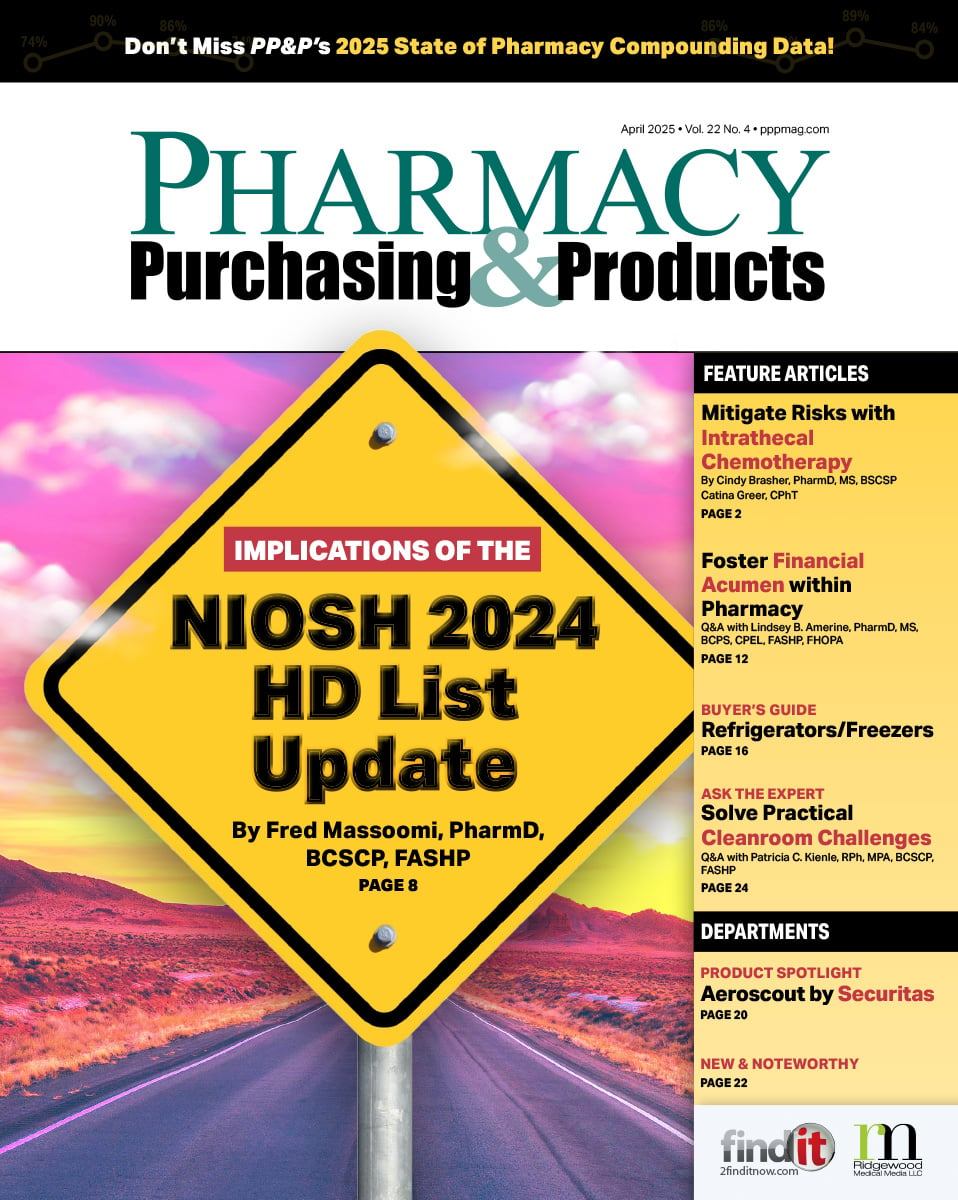- Show Menu
- Contact Us
- FAQs
- Reader Service
- Survey Data
- Survey Winners
- Testimonials
- Upcoming Events
- Webinars
- White Papers
The Current State of Drug Shortages


 Q&A with Michelle Wheeler, PharmD, and
Q&A with Michelle Wheeler, PharmD, and
Rachael Freeman, PharmD, BCPS
Drug Information Specialists
University of Utah Health
Pharmacy Purchasing & Products: What recent drug shortage trends has the University of Utah Drug Information Service (UUDIS) identified?
Michelle Wheeler, PharmD, and Rachael Freeman, PharmD, BCPS: Historically, the emblematic shortage was a generic product intended for injection. Injectable drugs typically represent at least 50% of new shortages, with all other dosage forms combined accounting for the remaining new shortages. Manufacturing injectable products involves sterile processing; therefore, fewer manufacturers are equipped to produce these products.
Currently, only 40% of new shortages are of injectable products (although 2019 fourth-quarter data may alter the trend). This trend is different than other years where injectables were the majority of new shortages. See FIGURE 1 for the number of new injectable drug shortages by year. Note that shortages of other dosage forms can be complicated by the fact that oftentimes manufacturers do not provide availability information for non-injectable products.

Another element UUDIS tracks is the number of different suppliers that make a product that is on shortage. UUDIS recently began tracking products that have just one market supplier. We determined that approximately 18% of drugs currently on shortage have just one supplier. Any disruption to the manufacturing process of a sole-supplier product can have a significant and lasting impact on drug availability. For example, erythromycin lactobionate injection is a sole-supplier product that has been on shortage for several years. The supply disruption began as a result of manufacturing delays, but has persisted over time. Without any alternate manufacturers, the product has consistently remained on intermittent shortage.
PP&P: What notable shortages have occurred this year?
Wheeler and Freeman: A recent set of shortages arose due to FDA recalls of products contaminated with N-nitrosodimethylamine (NDMA) or N-nitrosodiethylamine (NDEA). Thus far, these recalls have impacted drugs in the angiotensin receptor blocker (ARB) class, as well as ranitidine. There are at least nine current shortages that have directly or indirectly resulted from these recalls. The ARB recall produced the most direct effect on shortages. Nearly every ARB on the market is currently in some form of shortage. While the ranitidine recall produced a direct shortage of ranitidine injection, it also caused indirect shortages of famotidine and cimetidine tablets due to increased demand. More information about these FDA recalls can be found at: www.fda.gov/drugs/drug-safety-and-availability/drug-alerts-and-statements.
Another interesting case arose from a shortage of tacrolimus capsules. Multiple manufacturers had the product on shortage, with one manufacturer citing a raw material shortage as the cause. Initially, the shortage only impacted immediate-release tacrolimus, but as the shortage continued, the injectable product and the extended-release oral products also went on allocation.
PP&P: How do the number of new shortages this year compare with the number of ongoing (ie, active) shortages?
Wheeler and Freeman: There have been 126 new shortages from January 1, 2019, through September 30, 2019 (see FIGURE 2). At the peak of 2019, there were 282 active shortages, but the average number is approximately 260 active shortages. This year has seen the highest rates of ongoing shortages since 2014, when at one point there were 320 active shortages.

PP&P: Which drug classes persist on shortage?
Wheeler and Freeman: The top classes of drugs on shortage are central nervous system (CNS) agents (including analgesics such as opioids); antimicrobials; cardiovascular agents; electrolyte, fluid, or nutritional products; and oncology drugs (see FIGURE 3). The longest-lasting shortages are of CNS agents, including neuromuscular blockers and opioid analgesics. Similarly, several injectable antimicrobial products have remained on shortage for almost 10 years. Although the supply of these medications has fluctuated over that time, it has never reached levels where the products could be considered fully recovered.

It is interesting to note that for all injectable drugs, the variety of product presentations available on the market can both ease supply issues while conversely ensuring that a product remains on shortage. For example, injectable morphine is available in vials, various proprietary Luer-lock prefilled syringes, ampules, and patient-controlled analgesia devices. Thus, the market may have at least one presentation available so that the supply is not fully depleted. The downside to this situation is that although the specific drug may not be fully depleted across all presentations, shortages continue when manufacturers are not able to provide adequate supplies of all the different presentations.
PP&P: How can stubborn shortages be remedied?
Wheeler and Freeman: Unfortunately, it is often unclear why shortages occur (see FIGURE 4). Drug manufacturers are not required to report reasons for supply disruptions to FDA or any other governing body. In 2018, the causes of just over half (51%) of active shortages that UUDIS followed were unknown. Additionally, the drug supply chain in the United States is extremely complex and often opaque. Until there is full transparency, it will be difficult to identify effective solutions to persistent shortages.

PP&P: Does the overall trend indicate an improvement or a worsening of drug shortages?
Wheeler and Freeman: Drug shortages remain relatively consistent. The high point for new shortages was in 2011, when 267 new shortages arose over the course of that year. Although recent years do not match that peak, many of the products that have gone on shortage have presented extreme challenges. Current shortage reporting is quantitative and does not fully express the impacts of drug shortages on end-users. The resources required to mitigate a particular shortage may be significant while another shortage may be easier to remedy.
An example is the sterile saline shortage that worsened in late 2017 after Hurricane Maria damaged a key manufacturing plant in Puerto Rico. Use of sterile saline is ubiquitous in hospitals, so shortage mitigation required changes to drug administration, use of less favorable substitutes, and changes to long-established compounding practices. Most hospitals had to manage the sterile saline shortage on a daily basis. Few drug shortages have had such a widespread impact.
Conversely, the shortage of haloperidol tablets caused relatively minor issues. At the peak of the current shortage, small dose haloperidol tablets (0.5 mg and 1 mg) were not available. However, health systems may not have felt a significant impact, as haloperidol is not used as widely as sterile saline. In addition, an oral solution of haloperidol was available and unaffected by the shortage.
While both the saline shortage and the haloperidol tablet shortage are weighted equally in the annual aggregation of shortages, the resulting impacts to clinical practice were significantly different. Thus, while the number of shortages can be quantified, this information only tells part of the story.
PP&P: What legislation has been introduced to address the problem of drug shortages?
Wheeler and Freeman: Senate bill 2723: Mitigating Emergency Drug Shortages (MEDS) Act1 was introduced in late October 2019. If passed, this legislation would:
- Require manufacturers to disclose the causes and expected duration of medication shortages
- Require manufacturers to create detailed plans to maintain availability for medications
- Grant the FDA expanded ability to expedite inspections and new drug applications in order to help mitigate shortages
- Assign the Departments of Health and Human Services and Homeland Security to assess the national security impact of critical product supplies
- Allow the Department of Health and Human Services to develop incentive programs for manufacturers to domestically produce active pharmaceutical ingredients and final dosage forms
Although shortages are a complex problem, this legislation could help mitigate the downstream effects of drug shortages. More information about this bill can be found at: www.ashp.org/News/2019/11/07/Senate-Bill-Includes-New-Tools-to-Tackle-Drug-Shortages
Reference
- Congress.gov. S.2723—Mitigating Emergency Drug Shortages Act. www.congress.gov/bill/116th-congress/senate-bill/2723
Michelle Wheeler, PharmD, is a drug information specialist at University of Utah Health. She completed her training at the University of California San Francisco School of Pharmacy, including a PGY1 pharmacy practice residency in 1994 and a PGY2 pharmacokinetics residency in 1995.
Rachael Freeman, PharmD, BCPS, is a drug information specialist at University of Utah Health. She graduated from the University of Illinois Chicago College of Pharmacy in 2017. Rachael completed her PGY1 pharmacy residency and PGY2 drug information residency at University of Utah Health.
Like what you've read? Please log in or create a free account to enjoy more of what www.pppmag.com has to offer.








